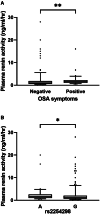Oxytocin Receptor Polymorphism Is Associated With Sleep Apnea Symptoms
- PMID: 39606181
- PMCID: PMC11590662
- DOI: 10.1210/jendso/bvae198
Oxytocin Receptor Polymorphism Is Associated With Sleep Apnea Symptoms
Abstract
Context: Oxytocin supplementation improves obstructive sleep apnea (OSA), and animal studies suggest involvement of oxytocin in respiratory control. However, the relationship between endogenous oxytocin signaling and human sleep status remains undetermined.
Objective: In this study, we approached the contribution of the intrinsic oxytocin-oxytocin receptor (OXTR) system to OSA by genetic association analysis.
Methods: We analyzed the relationship between OXTR gene polymorphisms and sleep parameters using questionnaire data and sleep measurements in 305 Japanese participants. OSA symptoms were assessed in 225 of these individuals.
Results: The OXTR rs2254298 A allele was more frequent in those with OSA symptoms than in those without (P = .0087). Although total scores on the Pittsburgh Sleep Quality Index questionnaire did not differ between the genotypes, breathlessness and snoring symptoms associated with OSA were significantly more frequent in individuals with rs2254298 A genotype (P = .00045 and P = .0089 for recessive models, respectively) than the G genotype. A multivariable analysis confirmed these genotype-phenotype associations even after adjusting for age, sex, and body mass index in a sensitivity analysis. Furthermore, objective sleep efficiency measured by actigraph was not significantly different between genotypes; however, subjective sleep efficiency was significantly lower in the rs2254298 A genotype (P = .013) compared with the G genotype. The frequency of the A allele is higher in East Asians, which may contribute to their lean OSA phenotype.
Conclusion: The OXTR gene may contribute to OSA symptoms via the respiratory control system, although it could be in linkage disequilibrium with a true causal gene.
Keywords: genetic association study; obstructive sleep apnea; oxytocin; oxytocin receptor.
© The Author(s) 2024. Published by Oxford University Press on behalf of the Endocrine Society.
Figures



Similar articles
-
Genotype-genotype interactions of the OXTR gene polymorphisms are associated with self-reported daytime dysfunction, sleep latency and personal distress.J Sleep Res. 2023 Feb;32(1):e13668. doi: 10.1111/jsr.13668. Epub 2022 Jun 15. J Sleep Res. 2023. PMID: 35706410
-
Polysomnography in patients with obstructive sleep apnea: an evidence-based analysis.Ont Health Technol Assess Ser. 2006;6(13):1-38. Epub 2006 Jun 1. Ont Health Technol Assess Ser. 2006. PMID: 23074483 Free PMC article.
-
Review of eating disorders and oxytocin receptor polymorphisms.J Eat Disord. 2021 Jul 13;9(1):85. doi: 10.1186/s40337-021-00438-0. J Eat Disord. 2021. PMID: 34256847 Free PMC article. Review.
-
The oxytocin receptor rs2254298 polymorphism and alcohol withdrawal symptoms: a gene-environment interaction in mood disorders.Front Psychiatry. 2023 Jul 14;14:1085429. doi: 10.3389/fpsyt.2023.1085429. eCollection 2023. Front Psychiatry. 2023. PMID: 37520225 Free PMC article.
-
Polymorphism of the Serotonin Transporter Gene and the Peripheral 5-Hydroxytryptamine in Obstructive Sleep Apnea: What Do We Know and What are We Looking for? A Systematic Review of the Literature.Nat Sci Sleep. 2021 Feb 9;13:125-139. doi: 10.2147/NSS.S278170. eCollection 2021. Nat Sci Sleep. 2021. PMID: 33603523 Free PMC article. Review.
References
-
- Terán-Santos J, Jiménez-Gómez A, Cordero-Guevara J. The association between sleep apnea and the risk of traffic accidents. Cooperative group Burgos-Santander. N Engl J Med. 1999;340(11):847‐851. - PubMed
LinkOut - more resources
Full Text Sources
